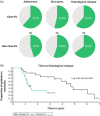Close follow-up is associated with fewer stricture formation and results in earlier detection of histological relapse in the long-term management of eosinophilic esophagitis
- PMID: 35384368
- PMCID: PMC9004232
- DOI: 10.1002/ueg2.12216
Close follow-up is associated with fewer stricture formation and results in earlier detection of histological relapse in the long-term management of eosinophilic esophagitis
Abstract
Background and aims: No recommendations exist regarding optimal follow-up schedule in patients with eosinophilic esophagitis (EoE) under maintenance treatment.
Methods: We retrospectively evaluated a long-term surveillance concept at the Swiss EoE clinic, where clinical, endoscopic and histological disease activity is assessed annually regardless of EoE symptoms. Data on 159 adult patients under maintenance steroid treatment with available follow-up were analyzed. Patients were classified as having close (duration between visits <18 months) or non-close follow-up (≥18 months).
Results: We analyzed a total of 309 follow-up visits of 159 patients (123 males, age at diagnosis 38.9 ± 15.4 years). 157 (51%) visits were within a close follow-up schedule (median duration between visits of 1.0 years (interquartile range (IQR) 0.9-1.2)), while 152 visits (49%) were not (median duration between visits 2.9 years (IQR 2.0-4.1)). There was no difference regarding ongoing clinical, endoscopic, and histological disease activity, and adherence to prescribed steroid treatment between the two groups. However, stricture formation was significantly less frequently observed at visits within a close follow-up schedule (22.9 vs. 33.6%, p = 0.038). Absence of close follow-up was a significant risk factor for stricture development in a multivariate regression model. Patients who achieved histological remission and were followed within a close-follow-up schedule had significantly earlier detection of histological relapse compared to patients not within such close follow-up.
Conclusion: Close follow-up is associated with fewer stricture formation and appears to result in earlier detection of histological relapse in patients with eosinophilic esophagitis. We advocate for regular assessment of disease activity (every 12-18 months) in order to detect relapsing disease as early as possible, and therefore potentially minimize the risk for EoE complications.
Keywords: eosinophilic esophagitis; esophagus; long-term outcome; relapse; swallowed topical corticosteroids.
© 2022 The Authors. United European Gastroenterology Journal published by Wiley Periodicals LLC on behalf of United European Gastroenterology.
Conflict of interest statement
Ekaterina Safroneeva is a consultant for Celgene Corp., Regeneron Pharmaceuticals Inc., and Novartis. Luc Biedermann has received consulting fees and/or speaker fees from Falk Pharma, Esocap, Sanofi‐Aventis and Calypso Biotech. Philipp Schreiner received fees for consulting from Pfizer, Janssen and Takeda. Stephan R. Vavricka received consultant fees and unrestricted research grants from Vifor and Falk Pharma. Alain M. Schoepfer is a consultant for Falk Pharma, Adare Pharmaceuticals, Celgene‐Receptos, and Sanofi‐Regeneron. Hans‐Uwe Simon is a consultant for AstraZeneca, GlaxoSmithKline, and Esocap. Alex Straumann has consulting contracts with Actelion, Celgene‐Receptos, Falk Pharma, Roche‐Genentech, GlaxoSmithKline, Novartis, Nutricia and Sanofi‐Regeneron. Mirna Chehade received research support from Regeneron, Allakos, Shire/Takeda, AstraZeneca, Adare/Ellodi, Danone; and consulting fees from Regeneron, Allakos, Adare/Ellodi, Shire/Takeda, AstraZeneca, Sanofi, Bristol Myers Squibb, Phathom. Thomas Greuter has consulting contracts with Sanofi‐Regeneron and Falk Pharma, received travel grants from Falk Pharma GmbH and Vifor, and an unrestricted research grant from Novartis. The other authors (Lorenz Bon, Christian Bussmann, Talaya McCright‐Gill) have nothing to declare. No company representative was involved in conception, writing, or financing of this study.
Figures


References
-
- Liacouras CA, Furuta GT, Hirano I, Atkins D, Attwood SE, Bonis PA, et al. Eosinophilic esophagitis: updated consensus recommendations for children and adults. J Allergy Clin Immunol. 2011;128(1):3–20. e6; quiz 1‐2. - PubMed
-
- Attwood SE, Smyrk TC, Demeester TR, Jones JB. Esophageal eosinophilia with dysphagia. A distinct clinicopathologic syndrome. Dig Dis Sci. 1993;38(1):109–16. - PubMed
-
- Straumann A, Spichtin HP, Bernoulli R, Loosli J, Vögtlin J. [Idiopathic eosinophilic esophagitis: a frequently overlooked disease with typical clinical aspects and discrete endoscopic findings]. Schweiz Med Wochenschr. 1994;124(33):1419–29. - PubMed
-
- Hruz P, Straumann A, Bussmann C, Heer P, Simon HU, Zwahlen M, et al. Escalating incidence of eosinophilic esophagitis: a 20‐year prospective, population‐based study in Olten County, Switzerland. J Allergy Clin Immunol. 2011;128(6):1349–50. e5. - PubMed
-
- Straumann A, Spichtin HP, Grize L, Bucher KA, Beglinger C, Simon HU. Natural history of primary eosinophilic esophagitis: a follow‐up of 30 adult patients for up to 11.5 years. Gastroenterology. 2003;125(6):1660–9. - PubMed

